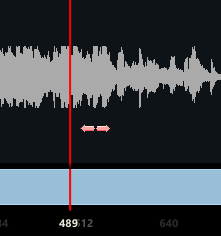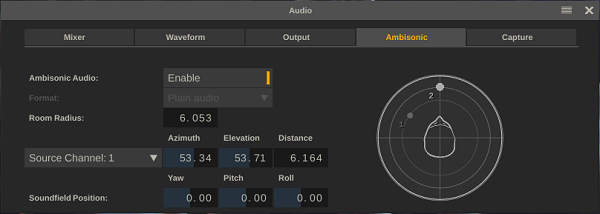GENERAL
There are different modules in SCRATCH for handling audio:
- Construct - Media Browser; (auto) link audio with individual shots and set the slip.
- Player - Audio Panel; Manage audio devices, channel mappings and volume. Slip and Auto Peak detection.
- Editor - Audio sub-menu; view audio waveform, link audio with individual shots or with the timeline as a whole and adjust the audio slip.

In SCRATCH audio can either be embedded with the underlying media, be linked to an individual shot, or linked to the timeline as a whole. If a timeline has audio linked to it, any audio linked to an individual shot is ignored for playback. Also, audio linked to a local shot overrides any embedded audio in the underlying media.
Each audio channel has its own waveform display in the Audio sub-menu. Note that you can re-size the menu-panel as discussed earlier in this chapter. The waveform will re-size with the menu-panel.
You can link multiple audio files to a single shot or to the Timeline. In the waveform display - all the channels of all the audio files are shown as separate tracks. You use the audio track selectors to change the selection from one audio file to the next. When selecting a track - the waveform display highlights all the channels that are in the same file as the selected track. The controls in the Audio menu apply to that audio file / those audio channels.
The controls at the top of the audio are split in two sections -Local and Timeline.The middle section is used to for channel selection.
LOCAL / TIMELINE
ADD
Opens a SCRATCH Browser to select an audio file that is subsequently linked to the current shot or the timeline as a whole.
Note: When loading a Broadcast Wave audio file for the current shot,SCRATCH will automatically calculate a slip value based on the shot and audio timecode. The audio timecode is based on the audio sample rate. In case of a shot with 23.976 drop-frame frame rate, SCRATCH uses an automatic override; if the audio file indicates a sample rate of 24, 48, or 96 kHz, SCRATCH will automatically use 24024, 48048 or 96096 respectively to compensate for the drop frame. To switch off this default behavior you can enable the Advanced Preferences variable Audio: Disable sample rate override. This sample rate override is purely for calculating the audio timecode and slip - not for playback.
REMOVE
Removes (all the channels of) the current selected audio file.
SLIP
Set a slip value to sync the video and the audio. Rather than setting the value through the numeric control, you can also drag the waveform as a whole to the left / right to adjust the slip. When you click anywhere in the waveform the cursor will change in a Slip cursor.

INFO
If an audio file is linked to the current shot or Timeline - the name of the audio file is displayed below the Local or Timeline buttons. On the far right of the sub-menu information is displayed about the audio device used for playback.
AUDIO CHANNELS
LINK CHANNELS
When enabled all the audio channels of all files that are linked to the current shot or Timeline will slip as one. If this button is not enabled - the slip control only applies to the current selected audio file.
UP / DOWN
Change the audio channel selection. The waveform display and audio track selectors indicate the current selected audio file and channel.
AMBISONIC AUDIO
You can load an Ambisonic or Spatial 360 audio file source in SCRATCH just like regular mono or stereo audio. When you click the Ambisonic Setup button in the middle of the Audio menu panel, SCRATCH opens the generic Audio panel with the Ambisonic tab active.

The right part of the Ambisonic panel is a graphical representation of the audio position of each channel in the ambisonic file relative to the 360 video display. When you have a headset attached, SCRATCH will automatically use the
positional data of the headset to direct the playback of the ambisonic audio.
ENABLE
In most cases SCRATCH recognizes whether the sound source is ambisonic or not. If you do not want an ambisonic sound source to be treated as such (but just as 4 mono channels) then you can disable the ambisonic option. Alternatively, you can force SCRATCH to treat the audio source as ambisonic if it did not recognize it s such automatically.
FORMAT
Set how SCRATCH should interpret the loaded audio source - in most cases SCRATCH will auto detect this.
- Plain audio: 4 mono channels.
- B-format AmbiX
- B-formar Fuma
SOUNDFIELD POSITION
The Yaw, Pitch and Roll controls allow you to re-center the audio to align it with the video.
ROOM RADIUS, AZIMUTH, ELEVATION AND DISTANCE
When interpreting individual audio tracks as ambisonic you need to assign the tracks a position using the Azimuth, Elevation and Distance controls as well as set the Room Radius for all the audio tracks. The Room radium more or less sets the level of sound decay relative to the center position and the Azimuth, Elevation and Distance controls work similar as the Yaw and Pitch controls to position the source relative to the listener. A more detailed description of these parameters you can find on https://en.wikipedia.org/wiki/Ambisonics.
These parameters only need to be set for a sound source that is not ambisonic already.